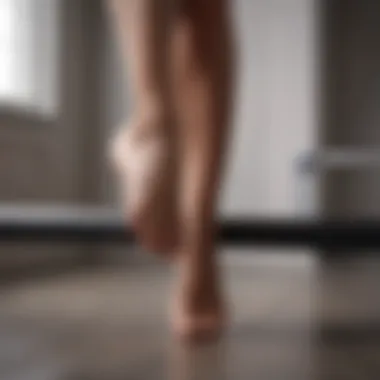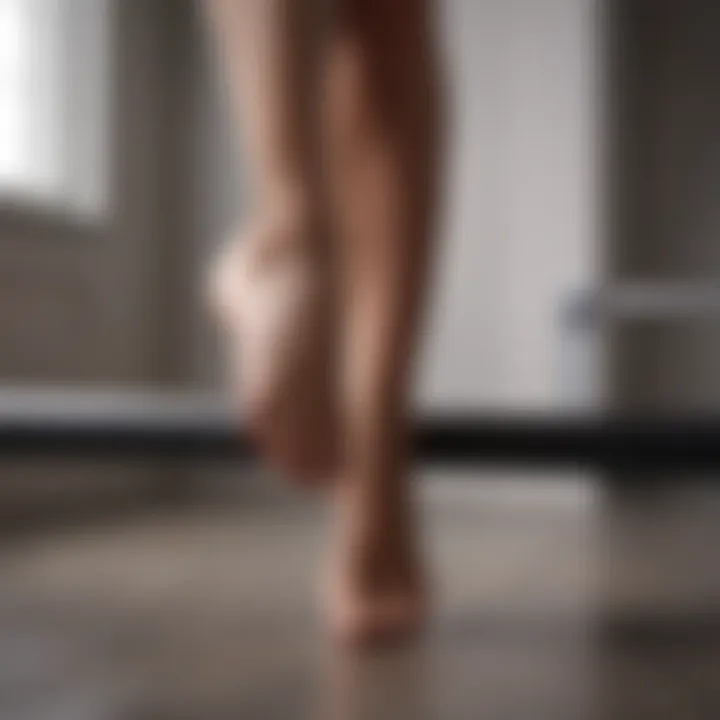Mastering Basic Barre Exercises for Fitness


Intro
Barre exercises have gained significant popularity in recent years, appealing to fitness enthusiasts across various demographics. Originating from ballet, these workouts combine elements of dance, Pilates, and yoga, focusing on strength, flexibility, and posture. This comprehensive guide seeks to elucidate the foundational principles of basic barre exercises, providing insight into their benefits for both physical health and mental well-being.
The essence of barre lies in its precise movements designed to target specific muscle groups, particularly the core, legs, and arms. This guide analyzes essential techniques and aid readers in integrating barre exercises into their routines effectively. Understanding the underlying scientific rationale can enhance the appreciation and efficacy of these workouts, ultimately fostering improved overall physical health.
In this exploration, we will cover fundamental concepts, variations suitable for different skill levels, and the lasting impact of barre on fitness and wellness. Join us as we delve into the world of barre fitness, unveiling the transformative potential of these exercises.
Prolusion to Barre Exercises
Barre exercises have been gaining popularity as a fitness method that blends elements of ballet, Pilates, and yoga. The approach not only emphasizes physical strength and flexibility but also encourages a deep focus on body awareness and alignment. Understanding the concept of barre exercises helps practitioners appreciate the precision involved and the benefits that come from engaging in this type of workout. As fitness routines evolve to incorporate practices that address both physical and mental well-being, barre stands out as an accessible option for many.
Understanding the Barre Concept
The barre is essentially a handrail used by dancers to support themselves while they perform a variety of movements. The significance of the barre within this fitness system extends beyond a mere prop; it represents stability and guidance. In a barre class, participants utilize the barre for balance while executing a range of targeted exercises. These exercises focus on small, controlled movements that enhance muscle tone and improve posture. With an emphasis on technique, barre exercises require participants to maintain precise alignment, which minimizes the risk of injury and maximizes efficiency.
Key characteristics of barre exercises include:
- Controlled Movements: These exercises typically involve small ranges of motion, engaging various muscle groups without the need for heavy weights.
- Focus on Muscle Engagement: Each exercise is designed to activate specific muscles, ensuring a full-body workout while targeting trouble areas.
- Combination of Cardio and Strength: Barre integrates elements of cardiovascular work alongside muscle strengthening, promoting overall fitness.
Historical Context
The origins of barre exercises can be traced back to ballet training in the early 20th century. Founded by ballet dancer, Lotte Berk, in the 1970s, this method was initially developed to help dancers maintain their strength and flexibility. Celebrated for its effectiveness, the technique gradually transitioned to wider fitness communities.
The foundational framework of barre combines classic ballet moves with modern fitness principles. As barre grew in popularity, various fitness studios began to adapt the concept, leading to different styles of barre classes that further broadened the appeal. While it maintains its roots in dance, barre has evolved to attract enthusiasts outside the traditional dance realm.
Today, barre classes are accessible to individuals of all skill levels. This inclusivity, along with the holistic physical benefits, has solidified barre exercises as a staple in contemporary fitness culture.
"Barre is not just an exercise; it’s a lifestyle choice that promotes a healthy body and mind."
Understanding both how the barre operates and the rich history that informs it provides a stronger foundation for anyone looking to incorporate barre exercises into their routine. By grasping these aspects, practitioners can fully engage in the workout and experience its numerous advantages.
Components of Barre Exercises
Understanding the components of barre exercises is crucial for anyone looking to engage with this unique form of fitness. It emphasizes not just the physical movements but also the mind-body connection and overall alignment of the body. The effective implementation of these components can enhance the quality of workouts and contribute to achieving fitness goals. The main components to consider are posture and alignment, muscle activation, and breathing techniques.
Posture and Alignment
Posture plays a vital role in barre exercises. Maintaining proper posture ensures that exercises are performed safely and effectively. It involves standing tall with shoulders back, engaging the core, and aligning the spine. This alignment helps distribute weight evenly throughout the body and prevents injury by reducing unnecessary strain on joints and muscles.
When practicing barre, the setup starts with finding a solid base. Feet should be hip-width apart in most positions, creating a stable foundation. Whether performing pliés or tendus, the importance of upright posture cannot be overstated. Not only does it enhance balance, but it also allows for a fuller range of motion, maximizing the benefits of each exercise.
"A strong posture supports everything else in barre, from movements to fitness outcomes."
Muscle Activation
Muscle activation is essential for targeting specific areas during barre workouts. Highly focused movements engage muscles that often go underutilized in everyday activities. In barre, small and controlled movements create significant impacts, effectively engaging glutes, thighs, and core muscles.
Each exercise is designed to isolate muscle groups, leading to greater strength and endurance over time. For instance, during a tendu, the focus is on activating the quadriceps while maintaining stability through the core. This targeted engagement is what sets barre apart from other fitness routines. Understanding how to activate the muscles effectively can enhance one’s performance and results in barre workouts.
Breathing Techniques
Breathing techniques in barre are key to maintaining focus and ensuring proper oxygen flow to working muscles. Although the movements may seem small and controlled, a rhythmic breathing pattern can enhance performance. Deep, intentional breaths should coincide with movements to stabilize the body.
Inhale deeply at the beginning of a movement and exhale on the exertion. This technique not only aids in concentration but also helps in managing energy levels throughout the workout. Proper breathing can reduce fatigue, ensuring that one can maintain the intensity and duration of the exercise.
In summary, the components of barre exercises—posture and alignment, muscle activation, and breathing techniques—are fundamental for ensuring a productive and safe barre experience. Understanding and applying these principles can lead to more effective workouts, enhancing physical fitness and overall health.
Basic Barre Exercises Explained


Barre exercises form the core foundation of this fitness regimen, merging traditional ballet movements with strength training and flexibility work. Understanding basic barre exercises is essential for anyone looking to enhance their physical fitness while enjoying a unique workout experience. These movements target multiple muscle groups, improve posture, and promote mind-body awareness. In this section, we will delve into specific barre exercises that are fundamental for practitioners. Each exercise serves a distinctive purpose, aiding in strength building, flexibility enhancement, and overall body conditioning.
Plies
Plies are fundamental barre exercises primarily used to warm up and establish a solid foundation for other movements. This exercise involves bending the knees while maintaining an upright posture. It primarily targets the thighs, calves, and core muscles. A proper execution of plies enhances balance and helps align the joints correctly, which is crucial for preventing injuries. When performing plies, remember to:
- Keep your back straight.
- Ensure your knees track over your toes.
- Engage your core throughout the movement.
Tendus
Tendus involve extending one leg along the floor and pointing the toes. This exercise emphasizes lengthening the muscles and increasing flexibility. Focus on the articulation of the foot while maintaining proper alignment. Tendus can also serve as a mindfulness practice, encouraging concentration as you engage one side of your body at a time. To effectively perform tendus:
- Maintain a strong core.
- Keep your leg straight when extending.
- Feel the point of your toes.
Degages
Degages build on the concept of tendus, but with a slight lift of the leg from the floor. Think of degages as a way to develop speed and precision in your movements. It helps strengthen the hip flexors, glutes, and thighs. Engaging in degages is vital for reinforcing the basic principles of high-intensity movements in barre classes. Important tips for executing degages:
- Keep your supporting leg slightly bent.
- Strike the floor with your foot as you return.
- Focus on the controlled movement rather than speed.
Rond de Jambes
Rond de Jambes translates to "circles of the leg" and involves moving the leg in a circular motion. This exercise enhances hip mobility, flexibility, and coordination. It can be performed on the ground or elevated, depending on skill level. Rond de Jambes work effectively for improving rotational movements of the hip joint. To execute rond de jambes:
- Keep your torso stable.
- Move slowly and with intention.
- Make big circles to engage the full range of motion.
Frog Stretch
The Frog Stretch is a deeply restorative movement, focusing on the inner thigh and hip flexibility. This exercise allows practitioners to relieve tension in the lower body and improve overall mobility. Being also a excellent cool-down exercise after vigorous barre workouts, it encourages relaxation in the muscles. Steps for an effective frog stretch include:
- Position yourself on all fours.
- Spread your knees wider than hip-width apart.
- Allow your hips to sink back gently while maintaining a flat back.
"Understanding basic barre exercises is essential not only for perfecting your practice but also for engaging your mind and body effectively."
The Benefits of Barre Exercises
Barre exercises offer a myriad of benefits that enhance physical and mental well-being. They combine elements of dance, Pilates, and yoga, creating a unique workout that is both challenging and accessible. Understanding these benefits is essential for those seeking to incorporate barre into their fitness routines. The importance of barre exercises can be seen in areas such as flexibility, strength, coordination, and the mind-body connection.
Improving Flexibility
One of the most notable benefits of barre exercises is their emphasis on flexibility. The movements in barre classes stretch and lengthen muscles, which is crucial for overall physical health. This is especially important as muscle tightness can lead to imbalances in the body, increasing the risk of injury.
During barre sessions, various stretches are performed that target different body areas. For example, certain pliés and tendus focus on hip flexors and hamstrings, while extensions target the calves. Over time, regular practice helps to increase the range of motion, allowing for greater ease in daily activities. Additionally, flexibility aids in improving posture and balance, further enhancing overall fitness.
"Increased flexibility enhances body functionality, helping individuals carry out everyday tasks with greater ease."
Enhancing Strength and Coordination
Strength and coordination are also significant outcomes of barre training. Barre workouts involve resistance movements that engage multiple muscle groups at once. This is particularly beneficial for building lean muscle mass without bulk. The isometric holds and repetitive movements in exercises like rond de jambes and degages demand a high level of control and precision.
As participants progress, they often notice improvements not just in strength but in overall body awareness. Enhanced coordination results from the combination of dynamic movements and focused muscle engagement. This awareness translates into better performance in other physical activities, thus supporting a well-rounded fitness routine.
Promoting Mind-Body Connection
Another profound benefit of barre exercises is the promotion of a strong mind-body connection. Barre requires concentration and mindfulness, as each movement must be performed with intention. This focus encourages participants to tune into their bodies, developing a deeper awareness of how different muscles engage and how the body moves overall.
Practicing barre can also serve as a form of moving meditation. It allows individuals to escape daily stressors and cultivate mental clarity. Many find that this enhanced focus can lead to improved mental health, reducing anxiety and fostering a sense of overall well-being. Establishing this connection between mind and body is essential for anyone pursuing long-term fitness goals.
Barre Techniques for Different Skill Levels
Understanding barre techniques tailored to different skill levels is essential. It ensures that individuals can engage with the exercises in a safe and effective manner. It also aids in building confidence and competence. Participants can progress at their own pace, which is critical in any fitness journey.


Beginner-Friendly Exercises
For those just starting out, beginner-friendly exercises are designed to build a strong foundation. These movements focus on proper posture and alignment, which are vital in barre. Simple plies and tendus allow beginners to become familiar with their bodies in the space of the barre. These movements enhance flexibility and promote muscle activation without overwhelming the individual.
Incorporating these exercises in a routine can develop strong lower body muscles. They also introduce the concept of controlled movements. Here are a few beginner exercises:
- Plies: A basic squatting motion that helps in understanding how to engage the legs.
- Tendus: Sliding the foot along the floor, which emphasizes control.
- Releves: Simple rising onto the toes, encouraging balance and coordination.
Intermediate Challenges
As confidence grows, so does the need for challenges. Intermediate exercises push the boundaries of strength and flexibility. They might include more complex movements like rond de jambes and degages. These exercises require more balance and coordination, enhancing muscle engagement across different body areas. Intermediate participants should also focus on refining technique, maintaining awareness of proper alignment.
When practicing intermediate techniques, participants can try:
- Rond de Jambes: These circles of the leg build not only strength but also flexibility.
- Degages: It helps improve muscle control and speed.
- Frog fits: It promotes deeper stretches and flexibility in hip areas.
Advanced Barre Practices
Advanced barre practices require thorough understanding and execution of previous techniques. These exercises are designed for individuals who have mastered the basics and are ready to take their practice to the next level. They may include complex combinations and dynamic movements that demand high levels of strength, endurance, and balance. Advanced barre practices not only strengthen muscles but also increase overall body awareness.
Advanced practitioners might consider:
- Developpes: Which involve extending one leg to the front, side, or back can enhance strength and flexibility in the hips.
- Grand Battements: They demand powerful leg lifts that also encourage muscle stability.
- Challenging sequences: Combining all previously learned techniques into a flowing routine.
"The best barre routine can challenge all skill levels while promoting individual growth."
Incorporating barre exercises appropriate for each skill level not only makes workouts more enjoyable but also provides a path for continuous improvement in fitness and well-being. By addressing different techniques, participants can build a thorough understanding of barre, ensuring everyone finds their place on their fitness journey.
Incorporating Barre into a Fitness Routine
Incorporating barre exercises into a fitness routine is crucial for both maximizing fitness benefits and ensuring sustained engagement. Barre combines elements of ballet, Pilates, and yoga, providing a unique exercise regimen that focuses on strength, flexibility, and posture. This blend offers various advantages for individuals seeking not just physical enhancement but also mental well-being. By understanding how to effectively integrate barre, practitioners can enjoy a balanced approach to fitness that complements their lifestyle and goals.
Creating a Balanced Schedule
A balanced fitness schedule is essential for anyone looking to incorporate barre exercises successfully. It is important to allocate specific days for barre, allowing for recovery and maintenance of other exercise forms. Here are some elements to consider:
- Frequency: Aim to practice barre exercises at least two to three times a week. This creates a routine that builds strength without overexerting the body.
- Cross-Training: Intersperse barre sessions with other workout types, like cardio or weightlifting, to create a holistic fitness plan. This can improve overall athletic performance.
- Rest Days: Include rest days in your schedule for recovery. Recovery is important for muscle rebuilding and strength gain.
Setting aside specific time slots for barre is advisable. Many individuals find early morning or late evening ideal, ensuring that workouts fit seamlessly into daily responsibilities. Ultimately, having a well-structured schedule reduces the risk of burnout and enhances motivation.
Combining Barre with Other Disciplines
Combining barre with other fitness disciplines creates a more effective and enjoyable workout routine. This integration can tap into varied muscle groups and promote overall physical health. Consider the following combinations:
- Cardio: Pairing barre with cardio, such as running or cycling, can boost endurance while barre strengthens muscles.
- Yoga: Integrating yoga asanas with barre movements enhances flexibility and mindfulness. This balance can lead to better body awareness and mental clarity.
- Strength Training: Performing strength workouts alongside barre can lead to improved muscle tone and definition. Focusing on weights can enhance the core work done in barre sessions.
Ultimately, integrating barre into varied disciplines allows practitioners to experience diverse benefits and keeps their routine fresh. Whether approaching barre as a standalone practice or as part of a larger routine, each element adds depth to the exercise experience.
In summary, incorporating barre into a fitness routine not only enhances physical abilities but also fosters a deeper understanding of movement and mind-body connection.
Practicing barre consistently, while coupled with other fitness forms, can transform one’s approach to health and fitness.
Common Misconceptions about Barre
Barre exercises have gained popularity in recent years, yet some misconceptions persist. These misunderstandings can prevent potential practitioners from enjoying the benefits of barre. Addressing these myths is essential to foster a broader understanding of what barre truly entails.
One key misconception is that barre is exclusively for dancers. While it is true that barre has roots in dance, this does not mean it is limited to this demographic. Barre classes are designed for individuals at various fitness levels and backgrounds. The movements focus on strength, flexibility, and posture, making them accessible to anyone willing to learn.
Barre is Only for Dancers
Many believe that barre workouts cater only to those with a dance background. This perspective is misleading. Although barre exercises draw from ballet techniques, their application extends far beyond the dance floor. People from different athletic backgrounds, including those untrained in dance, can benefit significantly from barre workouts.


Barre provides numerous advantages, including:
- Enhancing core strength
- Improving balance and flexibility
- Increasing muscular endurance
These outcomes are not reserved for dancers. Individuals wishing to improve their overall physical fitness can integrate barre into their routines. The low-impact nature of barre exercises makes them ideal for people of various ages and fitness levels. Thus, it encourages broader participation.
Barre Requires Extensive Equipment
Another common belief is that barre exercises necessitate a wide array of costly equipment. This idea can deter individuals from trying barre classes. In reality, the equipment used in barre workouts is minimal and often limited to a few specific items.
Common tools include:
- Barre (of course)
- Light dumbbells or resistance bands
- Exercise mats
Classes often utilize the barre itself for stability during exercises. At-home practices can be accomplished without any equipment as well. For example, using a sturdy chair or the wall can provide sufficient support. This accessibility makes barre suitable for various environments, from studios to home settings.
Barre can also be performed using bodyweight, which offers a practical way to achieve a full workout without any investment in specialized gear.
"Barre is an adaptable practice that can cater to individual needs without necessitating expensive equipment."
In summary, understanding barre exercises as accessible and beneficial for a wider audience is crucial. Addressing the misconceptions of being merely for dancers or requiring extensive equipment allows more individuals to embrace this form of exercise.
Safety Considerations
Safety in barre exercises is crucial for maintaining a beneficial workout experience. Engaging in these workouts without proper safety measures can lead to injuries or undue stress on your body. Understanding the elements of safety, especially warm-up and cool-down practices, can mitigate these risks and enhance the overall effectiveness of your fitness regimen. It's essential to pay attention to alignment, muscle engagement, and awareness during each movement.
Warm-Up and Cool-Down Practices
Starting each barre session with a proper warm-up prepares the body for physical exertion. Warming up raises your heart rate and elevates muscle temperature, which improves flexibility and reduces the risk of injury. This phase can include light cardio movements or specific stretches that gently engage the major muscle groups used in barre.
Cool-down practices are equally important. This phase allows your heart rate to gradually return to resting levels, promoting recovery and preventing dizziness or faintness. Incorporating deep stretches and breathing exercises into your cool-down can effectively relax the muscles worked during the session.
"Taking time for proper warm-up and cool-down phases sets the stage for an effective barre workout and significantly lowers the incidence of injuries."
Recommended Warm-Up Exercises:
- Gentle arm circles
- Leg swings (front to back and side to side)
- Mild squats to activate lower body muscles
Recommended Cool-Down Exercises:
- Forward fold stretch
- Child's pose
- Gentle neck stretches
Avoiding Common Injuries
Although barre exercises offer numerous benefits, practitioners can still face injuries if they do not use proper form or push their bodies too hard. Understanding common injuries and how to avoid them is vital.
Typically, injuries can occur due to inadequate muscle strength or flexibility, poor alignment, or performing moves too quickly without control. It's important to listen to your body and respect its limits.
Practicing mindfulness while exercising can help prevent injuries. If you feel discomfort or pain, it is advised to stop the exercise immediately.
Tips to Avoid Common Injuries:
- Focus on alignment: Ensure your knees are over your ankles and your back is straight during exercises.
- Maintain controlled movements: Quick or jerky motions can lead to strains.
- Strengthen weak areas: Focus on building the strength in underutilized muscles.
By implementing these safety considerations, you can maximize the benefits of barre exercises while significantly reducing the risk of injury. Engaging in a mindful and methodical practice will lead to a more productive and fulfilling experience.
Culmination
Barre exercises represent a well-rounded approach to physical fitness that emphasizes not only strength and flexibility but also a connection between the body and mind. This article highlights how basic barre exercises can be beneficial for individuals at various fitness levels. The careful integration of fundamental techniques like plies, tendus, and frog stretches serves to build a solid foundation for barre practitioners.
The Holistic Value of Barre Exercises
Barre exercises offer numerous benefits that extend beyond simple physical changes. They promote improved coordination and posture, enhance muscle tone, and contribute to greater body awareness. The combination of ballet-inspired movements with focused strength training creates an environment where both mind and body can flourish.
- Physical Benefits: Participating in barre exercises regularly can lead to improved flexibility and muscle endurance. It helps in toning muscles without adding bulk, which many fitness enthusiasts find appealing.
- Mental Well-being: The rhythmic movements associated with barre require concentration, promoting mindfulness which positively impacts mental health. Engaging fully in each exercise allows individuals to momentarily escape daily stressors.
- Community and Support: Barre classes often foster a sense of community. Exercising in a group setting encourages motivation and accountability.
"Engaging in barre not only transforms your physique but also nurtures your mental state."







